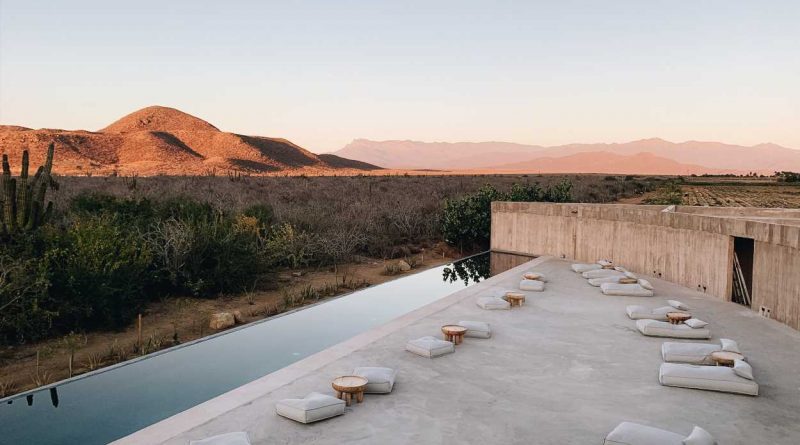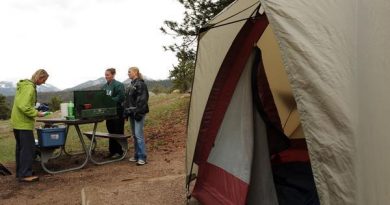Paradero Todos Santos: First In
The drive north from San Jose del Cabo to Paradero, a new hotel in Todos Santos, takes less than an hour along the well-maintained Highway 19 and one turn down a dusty country road. While some might see the approach to the property as a little sleepy compared to Cabo’s flashy resorts, I find myself fascinated by the sprawling fields of sprouting tomatillos and poblanos. Especially because I know Paradero prides itself on being a landscape project first and a hotel second, a rarity in the Baja California Sur peninsula of Mexico. Set on a previously unused 5.5-acre plot within a farming community in Todos Santos, it’s become the mission of Mexico City–based founders Pablo Carmona and Joshua Kremer to preserve the over 160 acres of family-owned farms that surround the property.
Beyond the fields, the 35-suite resort comes into sight. Set before a palm tree oasis about 20 minutes from the beach, it’s made up of a series of brutalist-inspired structures designed by architects Ruben Valdez and Yashar Yektajo. They took note of the landscape’s sunbaked hues and designed the property in golden shades to blend into the sandy natural surrounds. The buildings’ desert tones also allow the plants in the resort’s 100,000-square-foot botanical garden to pop: red sand verbena, Mojave yucca, and Shaw’s agave, to name a few.
Baltazar Gomez, the hotel’s assistant manager, gives me a tour of the grounds. He starts by handing me a spicy mezcal cocktail to enjoy in the heart of the property, which is a spacious lounge that feels like a giant living room. It’s an austere three-tiered concrete structure that’s been made cozy with myriad seating spaces: jute floor pillows made in Oaxaca, hammocks woven by Yucatan artisans, a golden tornillo table, and black leather recliners produced in Guadalajara. We continue with a walk to the outdoor spa, where foliage shades open-air massage huts and dueling hot-cold dipping tubs, before saying goodbye at my suite.
I take a staircase up to my rooftop suite, which is more a series of spaces than a traditional guest room. First, I come to an outdoor seating area with views of the cactus-studded desert below. This patio connects my sleeping area with my bathroom, both delightful in their simplicity. Up another set of stairs I find the main selling point: access to a “star net”—a flat hammock bolted into the walls and suspended over my outdoor space. Lying in it creates the sensation that you’re floating above the landscape while looking up at the sky above. The garden suites below mine don’t have the same view, but they do have other perks like a traditional hammock or an outdoor soaking tub.
Though the property’s architecture is exceptional enough to warrant a visit, a stay at Paradero is all about the included experiences. This is an ethos inspired by project advisor Jesús Parrilla, the former CEO of the South American–based adventure travel company Explora. The immediate landscape surrounding the resort has five distinct ecosystems to explore, and I make it my goal to know them all.
I start with a two-hour hike through cactus fields and a palm oasis to the deserted Las Palmas beach. Although it’s open to the public, we’re the only people around. I follow up the hike with a much-earned taco tour. Paradero’s team takes me to a series of local spots: ceviche tostadas at the tucked-away Tiki Santos Bar and fish tacos at Barracuda Cantina, the thatched-roof, sand-floored eatery is somewhat of a legend after being featured in the Netflix series Taco Chronicles. Another day, I go on a surfing excursion that the hotel sets up with Mario’s Surf School on the nearby Playa Los Cerritos beach. My instructor, Odin—named appropriately after the Norse god of magic and wisdom—gets me up on my board at least 20 times during our session.
Surfing and sitting in the sun has me predictably tired and hungry. After a refreshing dip in the 130-foot-long infinity pool, I wander down to the hotel’s restaurant and meet up with chef Eduardo Ríos. An alum of Enrique Olvera’s Mexico City restaurant, Pujol, he is now at the helm of the hotel’s open-fire kitchen. Ríos focuses on classic seafood dishes that spotlight the catch of the day from the nearby Pacific and the Sea of Cortez, like the citrusy and spicy aguachile ceviche I had along with the smoked cauliflower with truffle aioli and crispy pickles. All dishes arrive with fresh tortillas, warmed on a traditional Oaxacan clay oven, and are served alongside an army of salsas made from the 12 different types of chili peppers grown on the property.
I’ve tried almost all the experiences by the time my four-day stay is over, but I’m told that there are more in works, like boating and fishing expeditions, Baja-style cooking classes, as well as plans for self-guided running and biking adventures around the property’s farms and gardens.
On my last night, I returned to my suite to find a bonfire set up in the outdoor space and cushions and blankets laid out for me in my star net. By the light of the moon, I can see miles of rolling farmland, the Sierra La Laguna mountain range, and the shores of Las Palmas beach. I stay for over two hours, spotting Mars and the Big Dipper and almost fall asleep to the soundtrack of the sea.
Paradero is the first of its kind in Mexico, not unlike experience-based models you find in South America and Africa. It’s a singular place where adventure and luxury collide, making for a delightful departure from the all-inclusive, mega-resorts of Los Cabos and the more arty or surf-centric properties that Todos Santos is known for. It’s proof to the region (and even the country) that a sustainable property rooted in discovery can not only be profitable but also serve as a change agent to connect travelers with Mexico’s wild, rugged nature—and perhaps even protect it for generations to come.
Book now: $550 per night, including breakfast and one daily experience, expedia.com
All listings featured in this story are independently selected by our editors. However, when you buy something through our retail links, we may earn an affiliate commission.
Source: Read Full Article


